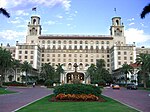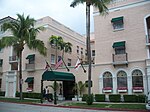Brelsford House
1903 establishments in Florida1975 disestablishments in FloridaBuildings and structures demolished in 1975Demolished buildings and structures in FloridaHouses completed in 1903 ... and 5 more
Houses in Palm Beach County, FloridaHouses on the National Register of Historic Places in FloridaNational Register of Historic Places in Palm Beach County, FloridaNeoclassical architecture in FloridaPalm Beach County, Florida Registered Historic Place stubs

The Brelsford House (also known as The Banyans) was a historic home in Palm Beach, Florida, United States, located at 1 Lake Trail. Built between 1888 and 1903, it was added to the National Register of Historic Places on May 3, 1974. The Neoclassical house was destroyed in August of the following year, but it remains on the Register.The house was built for E. M. Brelsford, Palm Beach's first postmaster; it was he who applied for a post office in "Palm Beach". He also founded the first store, a general store. The money to build the house came from the sale of his Palm Beach land to Henry Flagler. Brelsford is buried in Woodlawn Cemetery in West Palm Beach.
Excerpt from the Wikipedia article Brelsford House (License: CC BY-SA 3.0, Authors, Images).Brelsford House
Clarke Avenue,
Geographical coordinates (GPS) Address Nearby Places Show on map
Geographical coordinates (GPS)
| Latitude | Longitude |
|---|---|
| N 26.709722222222 ° | E -80.037777777778 ° |
Address
Clarke Avenue 227
33480
Florida, United States
Open on Google Maps











